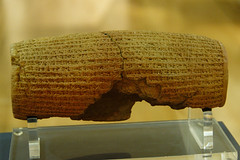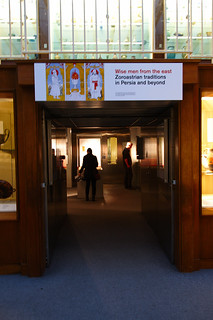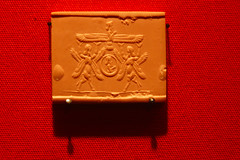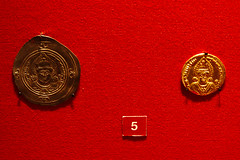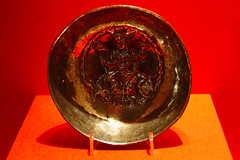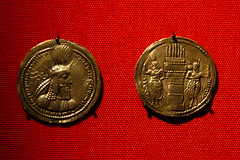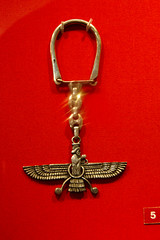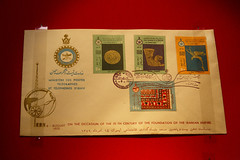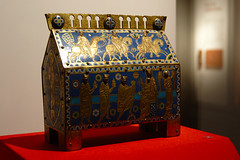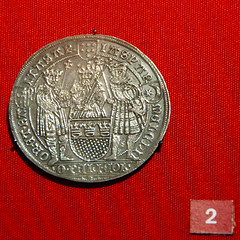The second episode of Wild Shepherdess with Kate Humble was all about alpaca farming in Peru. In the first half of the programme she stayed with a family who herd alpacas in a traditional way. To feed themselves they grow potatoes and keep guinea pigs. The guinea pigs have free reign of the house & are fed on the potato greens so they’re combination pet, recycler & dinner. According to Humble they taste like dark chicken meat. The alpacas are kept for their fibre – it’s not wool apparently, but that’s a technical distinction of some sort because it’s the equivalent of wool in all ways. The family shear the alpacas by hand with a kitchen knife, and then keep some of the fibre for themselves to spin and then make the very brightly coloured cloth that the region is famous for. The rest of the fibre is sold to a middleman who sells it on to the cloth industry. Because their herd is not pure-bred alpaca they don’t get much money for the fibre. In general their lives are hard, but they prefer it to moving to a city where the standard of living would in some ways be lower.
The second half of the programme took us through the way that the alpaca cloth industry in Peru is moving from this traditional style herding into the modern world. Humble started with a cousin of the subsistence farmers she’d been staying with. He’s both a collector (one of the middlemen who buy the fibre) and a farmer. Having seen where the fibre is sold to & the requirements he realises that the sort of herds that he & his cousin have aren’t the best – so he’s bought himself a pure-bred male alpaca & is gradually breeding his flock to have better quality fibre. Next Humble visited a man who herds alpacas in a large scale way. His ranch has thousands of alpacas (instead of the 60 or so that the first family have), and they are a particular breed that has very high quality fibre. Instead of just letting the animals mate as & how they choose he selects his best males & best females & breeds those. And being a large scale ranch owner I guess he also sells direct to the cloth industry rather than through a collector.
She then visited a cloth making factory. The cloth they make is mostly exported with China being the biggest buyer. They are particularly interested in helping to improve the herd quality of all their suppliers (including small farmers like the first family) because places like China & the US are starting to herd their own alpacas, so Peru’s advantage in the market will be in having the best quality fibre. And so Humble then went to visit an alpaca breeding research centre which is part funded by this cloth manufacturer. They’re working on developing artificial insemination techniques for alpacas with the idea that small farmers might not be able to afford a pure-bred male, but might be able to afford the semen to produce better quality offspring for their female alpaca. So the alpaca industry is just at the point where it’s optimising for the modern world and a global market, but it’s not quite there yet.
Translating the Bible into English doesn’t seem like a big deal in the modern world – I think I own 3 different English translations (plus a New Testament in Scots) – but in Tudor England it was heretical and punishable by death. One of the programmes in the BBC’s recent Tudor Court Season was The Most Dangerous Man in Tudor England, which was a biography of William Tynedale presented by Melvyn Bragg. Tynedale’s English Bible eventually formed the basis of the King James Bible, but Tynedale himself was regarded as the most dangerous man in England for producing it and executed for heresy.
Tynedale was born on a farm in Gloucestershire near the village of Slimbridge, which is still a working farm today. He was educated at Oxford – first in Magdalen College School, at the age of 8 in the early 1500s, then at Magdalen College. Bragg used this introductory bit to set the scene for Tynedale’s later translation. At the time the Bible was only available in Latin – the language of the Church and of scholars (the two groups overlapped to a high degree). The Catholic Church had built up over the centuries a collection of doctrines & traditions that weren’t actually in Bible (like Purgatory, the requirement for confession & penance to save one’s soul etc), and the hierarchy of the Church was positioned as necessary to save the souls of the congregation. Tynedale (and other Reformation thinkers) saw the way the Bible was only available in Latin as a power play on the part of the Church – keep the congregation from reading the actual text & you keep them reliant on the priests to explain it. And you keep anyone from noticing that the Church has these non-Biblical traditions.
Tynedale had always had the ambition to translate the Bible into English so that everyone could read it, and his education had only served to reinforce that. Bragg was telling us that when the students studied the Bible they only looked at verses in isolation, rather than reading the whole Bible & getting a feel for the overall text. During this time Tynedale learnt of the ideas of Erasmus who promoted the idea of reading a text in the original language to get the best handle on the text. For the Bible this would be Hebrew (for the Old Testament) and Greek (for the New) and Tynedale learnt these and other languages.
After Tynedale had graduated & been a priest for a little while he came into conflict with other clergy over his emphasis on the Word of God rather than the Church traditions. Bragg quoted from a description of an argument where another clergyman said that it was better to do without “God’s law than the canon law”, to which Tynedale reacted angrily – declaring that he would “cause the boy that driveth the plow to know more of the Scriptures than thou dost!”. This crystallised his desire to translate the Bible, and his first step was now to go to London to visit the Bishop of London & try and get backing for his project. This was the first of a few naive sounding things that Tynedale did in his life. The Bishop of London at the time was Cuthbert Tunstall, and Bragg described him as being a part of the Church orthodoxy & a close associate of people such as Thomas More. Unsurprisingly he didn’t back the heretical project that Tynedale proposed.
Realising that this would not end well, Tynedale eventually left not just London but also England and moves to Germany to work on his translation. Just to orient ourselves in the wider history I should point out that by this stage Martin Luther has started the Reformation in Germany, and it’s spreading through Europe. Henry VIII is on the throne of England, and had written his defence of the Catholic Church that earnt him the title of Defender of the Faith. So in moving to Germany Tynedale is aligning himself with the Protestant Reformation, and against the English Crown as well as the Catholic Church.
Tynedale completed his translation of the New Testament, and sought out a publisher in Cologne. Cologne was Catholic, but nonetheless he found someone who would produce the book and plans were made to print a few thousand copies & to smuggle them into England. Unfortunately for Tynedale his publisher was also contracted to work on a text for a member of the Catholic orthodoxy from England (Bragg told us who this was, but I’ve forgotten the name :/ ). The plans for the English New Testament were discovered & Tynedale had to flee with the project incomplete. He moved to Worms, and found himself another publisher so that he could restart the project. Tynedale’s life work wasn’t over with the printing of the New Testament, he continued to work on translating the Old Testament – going back to the Hebrew. Before his death he finished the first five books, which were also printed & subsequently distributed in England.
Bragg took the time at this point in the programme (and later on, near the end of it) to wax lyrical about Tynedale’s translation. He didn’t just translate it into English any old how, it was vivid & poetic language which sticks in the mind and has flavoured the whole of modern English – as much as Shakespeare did. Turns of phrase that Tynedale employed are still a part of our idioms today. But Tynedale didn’t just choose his words for maximum impact & memorability he also picked them to advance his Protestant ideas. So a word that was traditionally translated as “priest” became “elder”, and one that was traditionally translated as “Church” became “congregation”.
The authorities in England were obviously on the lookout for Tynedale’s Bible’s arrival in England, but several thousand copies still made their way into the hands of the more Protestant-minded members of the public. Bishop Tunstall preached against the English Bible, saying that it had errors and was heretical & blasphemous, and he presided over a bonfire outside St. Paul’s burning copies of Tynedale’s Bible. This didn’t quite go all the Bishop’s way – even those who might not’ve read the Tynedale text themselves weren’t entirely comfortable with burning the Word of God even if it was a potentially heretical version of it.
Thomas More led the hierarchy’s campaign against Tynedale’s work. There was a very amusing segment of the programme here where there were two Braggs on either side of a church aisle reading passages from More & Tynedale’s publications where they held forth on how dreadful and corrupt the other was. This had developed into a personal feud, not just an academic & political difference of opinion, and More at least started to resort to very vitriolic & foul-mouthed tirades against Tynedale. Including writing things like “You have kissed the ass of Luther and are now covered in shit”.
When Henry VIII was seeking to divorce Catherine of Aragon it looked like Tynedale would come into favour in court. This was because with the Pope refusing to grant the annulment Henry was searching for other ways to get what he wanted. Tynedale had published a treatise called The Obedience of a Christian Man, which was primarily arguing for everyone to read or hear the Word of God directly (so vernacular translations of the Bible are required so that the congregation as a whole can understand). But as part of it he said that Kings should not be subservient to the Church authorities – that God has anointed the King as the secular authority over a country and so the King should answer to God, not the Pope. Obviously Henry liked the sound of that, and used this as a plank in his splitting of the Church of England from Rome. But Henry still found the rest of Tynedale’s theology heretical (like the idea of an English Bible), and Tynedale went on to publish other treatises that didn’t sit as well with Henry including one opposing Henry’s divorce on the grounds that Henry’s use of scripture to justify it was an incomplete summary of the scriptural references to marrying one’s brother’s widow.
So Tynedale was still considered heretical, and Thomas More (amongst others) was still violently against Tynedale & all he stood for. Eventually Tynedale’s downfall was engineered by an agent of the English. This man, Henry Phillips, wormed his way into Tynedale’s good graces – he pretended to be a great admirer of Tynedale’s and to be interested in his theology. He then set up a trap – he came to Tynedale saying he had no money and got Tynedale to take him out for dinner. He then persuaded Tynedale to lead the way along a particular narrow secluded alleyway, and straight into the hands of soldiers of the Holy Roman Empire. Tynedale was imprisoned, and sentenced to death for heresy. Thomas Cromwell tried to intercede on Tynedale’s behalf, but was unsuccessful.
Tynedale was burnt to death, the typical punishment for a convicted heretic. As an act of mercy he was strangled before the fire was list, but this strangulation was incompetently carried out. Tynedale revived during his burning, but witnesses say he was stoic & silent as he died. (Which seems somewhat unbelievable.)
His Bible translation did not die with him, and Tynedale regarded that as more important than his own life. Cromwell eventually persuaded Henry VIII to endorse an English Bible, and the text of this was primarily that of Tynedale’s translation. Tynedale wasn’t credited, however, because he was still regarded as a heretic (and Henry still carried a grudge against him for not approving of the divorce). The Henry VIII Bible fed into the King James Bible translation, and so Tynedale’s words and work still lived on.


